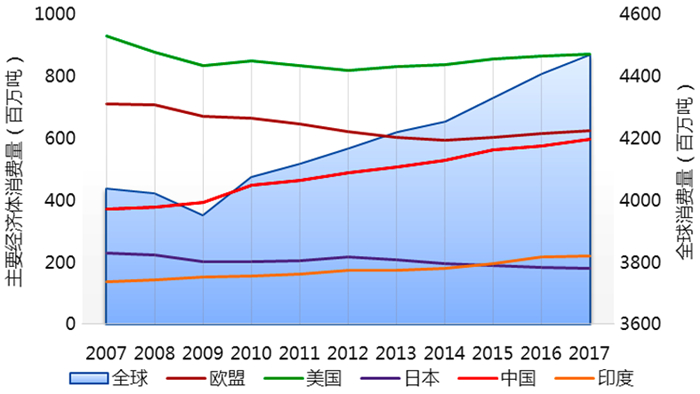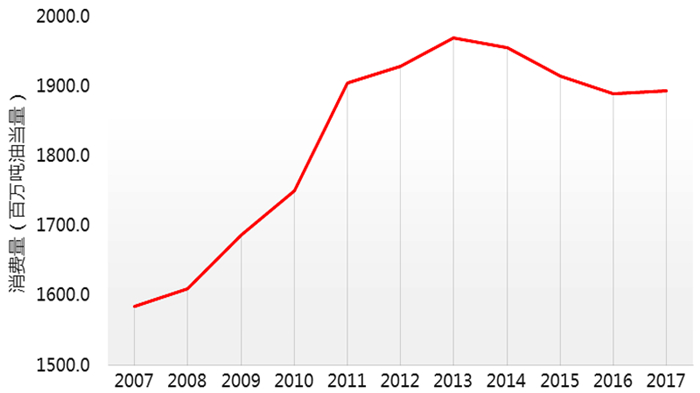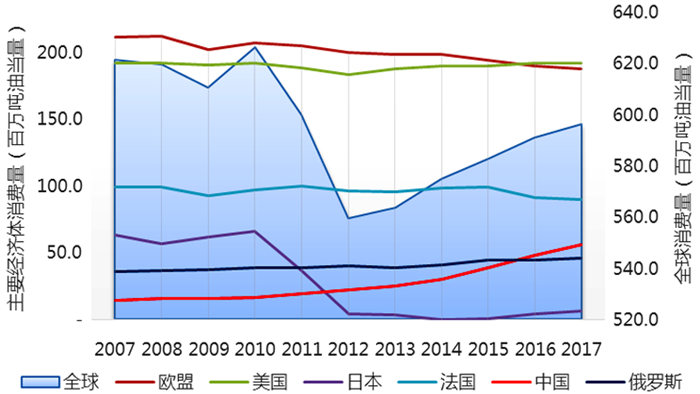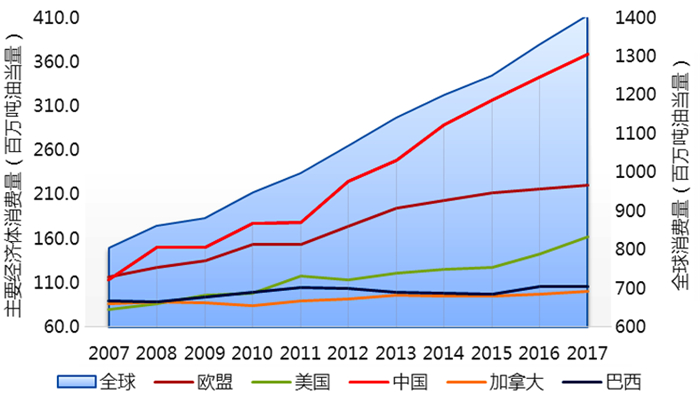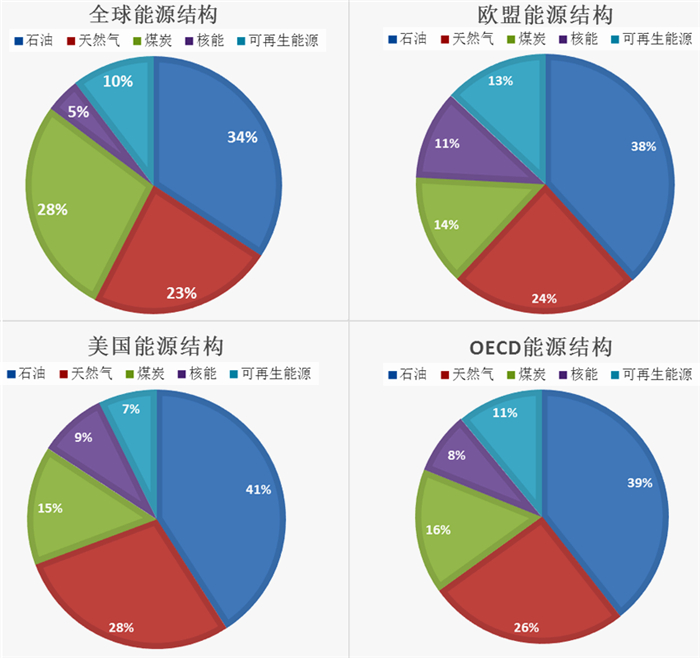Analysis on the Current Situation and Development Trend of Energy Resources in China
-
摘要:
基于权威数据,开展中国能源现状及发展趋势研究。系统分析研究了世界能源现状,针对石油、天然气、煤炭、核能、可再生能源分别展开论述;在此基础上,着眼国内,立足中国能源资源禀赋,分析中国各类能源资源的储量、产量和消费现状,合理预测了中国能源发展趋势,指出了我国能源发展存在的问题,相应提出了几点建议。
Abstract:On the basis of authoritative data, the research on the status quo and development trends of China's energy sources is carried out. The world energy status is analyzed systematically in terms of oil, natural gas, coal, nuclear energy, and renewable energy. Sequentially, the domestic energy resources status, including the reserves, production, and consumption of all types of energy resources in China are analyzed. Finally, the trend of China's energy development is predicted reasonably, and the existing problems are pointed out with several corresponding suggestions.
-
Key words:
- China /
- energy /
- current situation /
- oil /
- natural gas /
- nuclear power /
- coal /
- renewable energy
-

-
表 1 全国石油资源主要分布盆地
Table 1. Distributions of national petroleum resources in basins
盆地 地质资源量/亿t 可采资源量/亿t 渤海湾(陆上) 242.87 65.58 鄂尔多斯 158.38 26.72 松辽 134.28 39.86 塔里木 120.65 27.94 渤海湾(海域) 110.29 25.37 准噶尔 106.73 22.02 珠江口 74.32 29.63 羌塘 50.95 11.21 柴达木 38.19 6.24 北部湾 21.18 5.1 二连 17.84 2.67 四川 16.11 1.29 三塘湖 15.52 1.55 琼东南 14.89 6 措勤 11.04 1.64 海拉尔 10.1 2.01 合计 1 143.34 274.84 全国 1 257.13 300.67 注:数据来自2015年全国油气资源动态评价。 表 2 全国常规天然气资源主要分布盆地
Table 2. Distributions of national natural gas resources in basins
盆地 地质资源量/亿m3 可采资源量/亿m3 四川 206 907 112 031 塔里木 163 100 98 000 鄂尔多斯 154 542 85 721 东海 60 479 33 262 琼东南 51 607 32 977 松辽 49 566 22 120 莺歌海 44 209 27 232 柴达木 33 390 18 271 珠江口 29 958 17 264 准噶尔 24 676 10 156 渤海湾(陆上) 17 264 8 246 渤海湾(海域) 12 977 5 840 合计 848 675 471 121 全国 902 920 500 827 注:数据来自2015年全国油气资源动态评价。 -
[1] BP. Statistical review of world energy 2018[R]. London: BP, 2018.
[2] 国家统计局. 中华人民共和国2017年国民经济和社会发展统计公报[R]. 北京: 中国统计出版社, 2018.
[3] 国土资源部油气资源战略研究中心. 全国油气资源动态评价(2015)[R]. 北京, 2016.
http://www.cnki.com.cn/Article/CJFDTOTAL-GWCJ201603023.htm [4] 自然资源部. 2017中国土地矿产海洋资源统计公报[R/OL]. (2018-05-18)[2018-06-21]. http://gi.mlr.gov.cn/201805/t20180518_1776792.html.
[5] 中国地质调查局. 中国地质调查局百项成果[R]. 北京: 地质出版社, 2016.
[6] World Nuclear Association. China's Nuclear Fuel Cycle[R]. London: WNA, 2017.
http://www.sciencedirect.com/science/article/pii/S0149197017300550 [7] 国务院. 能源发展战略行动计划(2014-2020年)[R/OL]. (2014-11-19)[2018-3-03]. http://www.gov.cn/xinwen/2014-11/19/content_2780748.htm.
[8] 中国核能行业协会. 2017年1-12月全国核电运行情况[R/OL]. (2018-01-30)[2018-04-09]. http://henenghangye.kechuangfu.com/site/content/32110.html.
[9] 国家发展改革委. 全国水力资源复查成果[R/OL]. (2005-11-28)[2018-04-13]. http://www.gov.cn/gzdt/2005-11/28/content_111272.htm.
[10] 中国气象局风能太阳能资源评估中心.中国风能资源的详查和评估[J].风能, 2011(8):26-30. http://d.old.wanfangdata.com.cn/Periodical/fengn201108004
[11] 中国气象局. 2016年中国风能太阳能资源年景公报[R/OL]. (2017-01-11)[2018-04-11]. http://www.cma.gov.cn/2011xwzx/2011xqxxw/2011xqxyw/201701/t20170111_385897.html.
[12] 朱瑞兆, 马胜红, 杨振斌, 等. 中国分省太阳能资源图集[R]. 北京: 中国气象局, 2006.
[13] 国家发展改革委, 国家能源局. 能源生产和消费革命战略(2016-2030)[R]. 北京: 国家发展改革委国家能源局, 2016.
http://www.cnki.com.cn/Article/CJFDTotal-SJCZ201710005.htm [14] 国家发展改革委, 国家能源局. 能源发展"十三五"规划[R/OL]. (2016-12-26)[2018-03-25]. http://www.ndrc.gov.cn/zcfb/zcfbtz/201701/t20170117_835278.html.
-




 下载:
下载:
